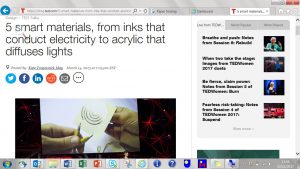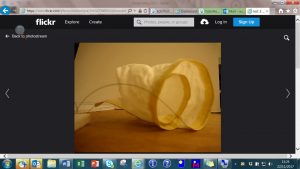“We may not yet have the flying car that science fiction promised us,” says Catarina Mota (TEDGlobal 2012). “But we can have walls that change color depending on temperature, keyboards that roll up, and windows that become opaque at the flick of a switch.” In this TED Talk video Moto shows some interesting examples.
The notion of what this means for the artefacts that incorporate smart or modern materials, and the parameters that constrain designers becomes, in my opinion, increasingly elastic.
I have been fascinated by smart and modern materials ever since I first played with a piece of smart nitinol wire in 1996 and squeezed my first piece of smart memory foam. I still feel awe when I see new ones evolve and unfurl into our world. Smart nitinol wire and smart memory foam are just two of many smart and modern materials around.
5 smart materials; inks that conduct electricity, thermochromic pigments, electrotextiles and acrylics that diffuse light are showcased in this TED talk video here. At the time of this 2012 video, Catarina Moto enthuses about how this expands the capacity to make awesome things but finds that information is sparse, in terms of how they are produced and how they work, or might be used. She co-created OpenMaterials.org for people to share exactly this on.
With respect to how smart and modern materials work, I have been part of a 2 year project at a secondary school level to educate teachers and students in 100 schools to ‘unpack the Science behind’ a range of these, funded by a Lord Mayor STEM fund. An understanding of this demystifies them considerably and is I feel desirable in order to use them effectively.
In terms of learning how others are using and intend to use them, my observation is that examples and experiments are constantly popping up across social media platforms, which is exciting!
Here are some of my personal favorites which expand on Moto’s examples:
Glow in the Dark (Phosphorescent Pigments)

Maiko Takeda is a Japanese millinery designer and showcased a series of spectacular sculptural headpieces covered in acetate bristles and hand painted with Glow in the dark pigments as part of her MA collection. Takeda moved to London in 2005 to study and completed a BA in jewellery design at Central Saint Martins, and then a MA in millinery at the RCA. “What I love about London is that I get to meet people from all over the world with different cultural backgrounds and perspectives,” “It makes me realise who I am and frees up my mind, which doesn’t often happen in Tokyo, being mostly surrounded by Japanese people” (Dazed, July 2012).She is currently an accessories designer. for Issey Miyake
A British company ProTeq Lighting have developed Starpath, a spray-on glow in the dark system that lights up pathways at night. It is being trialled in Christ’s Pieces Park in Cambridge and has potential for bike paths and footpaths there and elsewhere. The UV crystals absorbs UV light in the daytime and then releases this energy as light at night in an ethereal way in this picture (8 May 2016) and there is more information in a video available here (MacMichael, 2013).
Shape Memory Alloy Futuristic Spacesuit

Historically, an astronaut wears a bulky suit, pressurised by gas. MIT (funded by NASA and the MIT Portugal Program) have designed a lighter weight stretchy spacesuit that is more like a second skin. Their version is lined with a network of coils of Smart Memory Alloy Coils.
Shape-memory alloy (SMA) are sometimes known as smart wire or nitinol wire and as with all smart materials, it “remembers” a shape that it has been set or made to, and when curved, stretched or deformed in different ways or as a result of different stimuli (e.g. but not limited to heat/moisture/chemical change/ heat etc.) it will be able to return to its original shape once the stimulus is removed. In essence, when this SMA suit is plugged in to a power supply, the coils will contract, thus hug and support the body like a second skin (Chu, 2014).
Ted Ulrich shows some playful ‘tests’ with smart memory wire in flickr videos (available by scrolling left and right once the first one opens) here
Not only fun to watch, they give a sense of the wire contraction possible and the related movement. The stimulus in these videos is current from a battery that causes the wire to contract and when removed, the wire will again relax and return to its original length.
It is worth keeping an eye out for other smart and modern materials and perhaps consider incorporating them creatively into your designs.
Asma Chowdhry




Leave a Reply